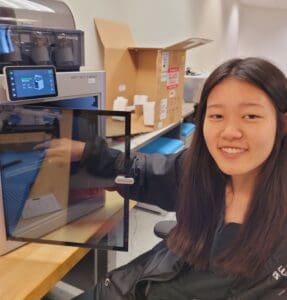
Claire is currently double majoring in Electrical Engineering and Geography at the University of Hawai?i at Manoa and plans to graduate with her BS and BA in 2025. She was born and raised in Honolulu, Hawai?i and attended Moanalua High School, graduating in 2021. Her future plans involve a career in renewable energy and sustainability, with the overarching goal of helping the state of Hawai?i and the University achieve their respective 2045 and 2035 renewable energy goals. Aside from that, she hopes to once again pick up an instrument and sports after her project wraps up.
Home Island: Oahu
High School: Moanalua High School
Institution when accepted: University of Hawaii at Manoa
Designing and Installing a 3D-Printed Environmental Enclosure for a Ground Telescope Optical Train
Project Site: KBR, Kihei, HI
Mentors: Dylan Schwarzmeier & James Cobb
Project Abstract:
The optical train, located on the back of a telescope, houses delicate equipment, cameras, filters, and focusers that are necessary to its operation. During inclement weather, this equipment is exposed to the elements for the time it takes the dome to close. In order to prevent damage to this expensive equipment, this project involved the design, fabrication, and installation of a protective environmental enclosure to surround the optical train of KBR’s Apertura 12″ f/8 Ritchey-Chretien Optical Tube telescope. This enclosure must not interfere with the movement of the telescope on the Paramount MX mount, nor with the existing cooling fans or wiring in place on the back of the telescope. Furthermore, it must allow for easy access to the equipment inside and appropriate temperature regulation. First, different types of technologies commonly utilized for virtualizing physical components/environments (LiDAR, photogrammetry) were evaluated and down-selected. Next, a photogrammetric model, schematics, and 3D-printing were utilized to complete this task. The model and schematics aided in formulation of the enclosure’s computer-aided design using Fusion 360 software. The final design was 3D-printed, then assembled on the back-end of the telescope, along with a 120-mm air-handling system. The finished enclosure now protects against precipitation and corrosive environments. KBR will be immediately leveraging the results, technologies, software packages, and air-handling design with future different telescope optical-train assemblies, as well as with a second style of telescope mount that rotates on altitude-azimuth axes.